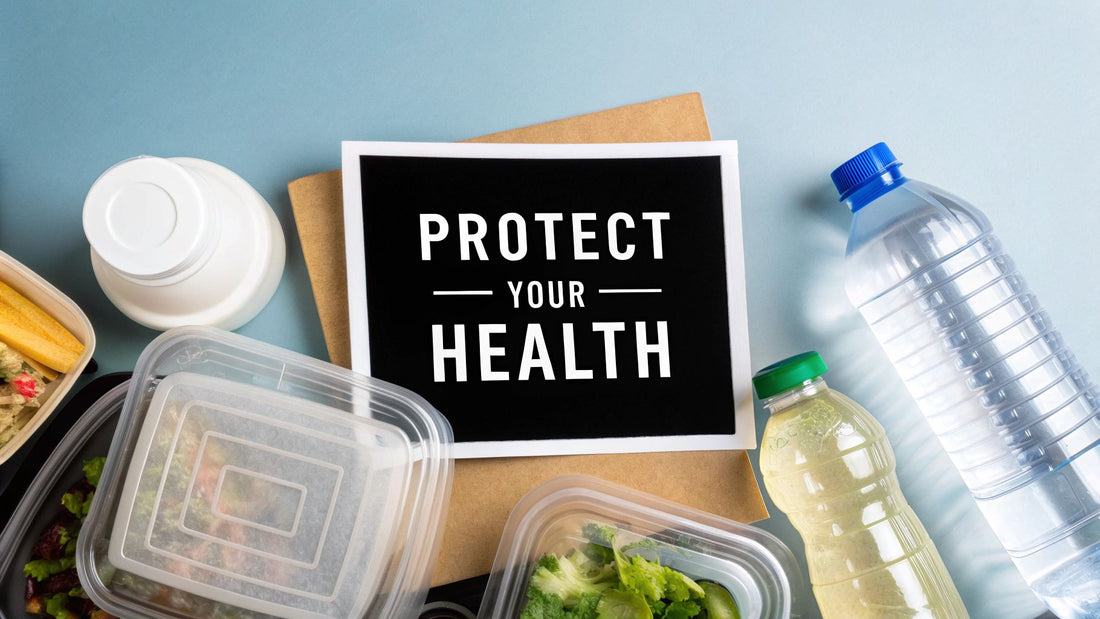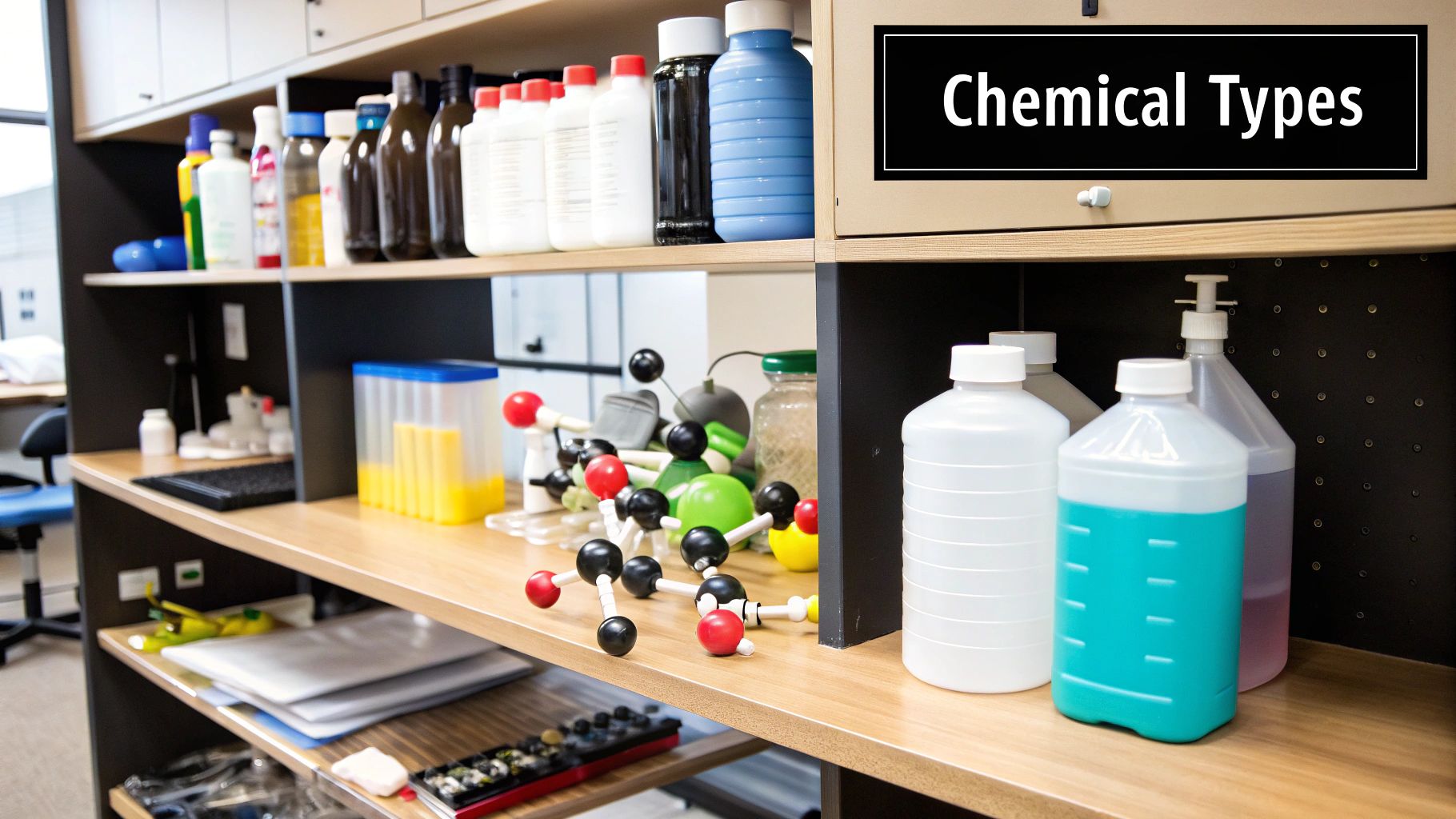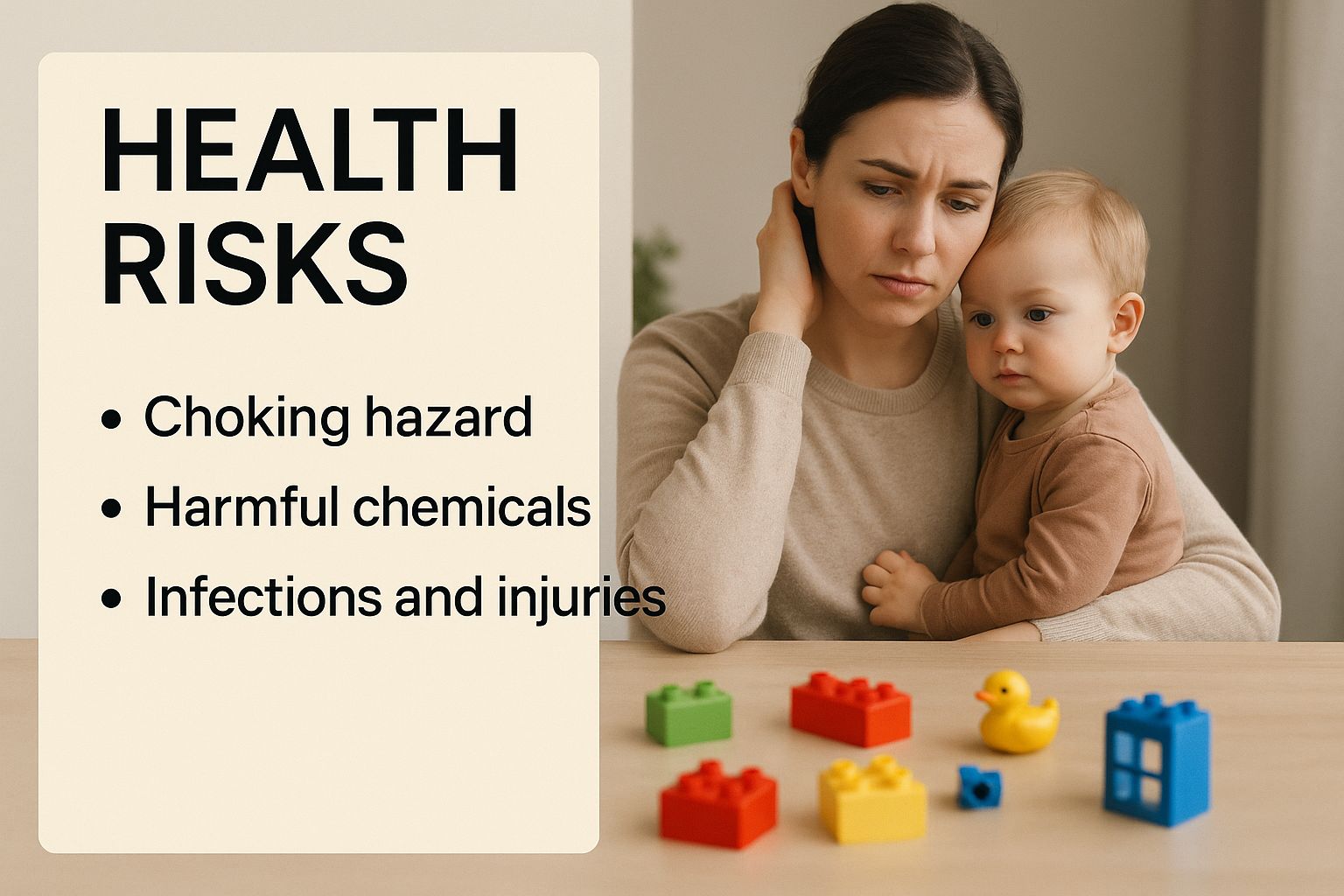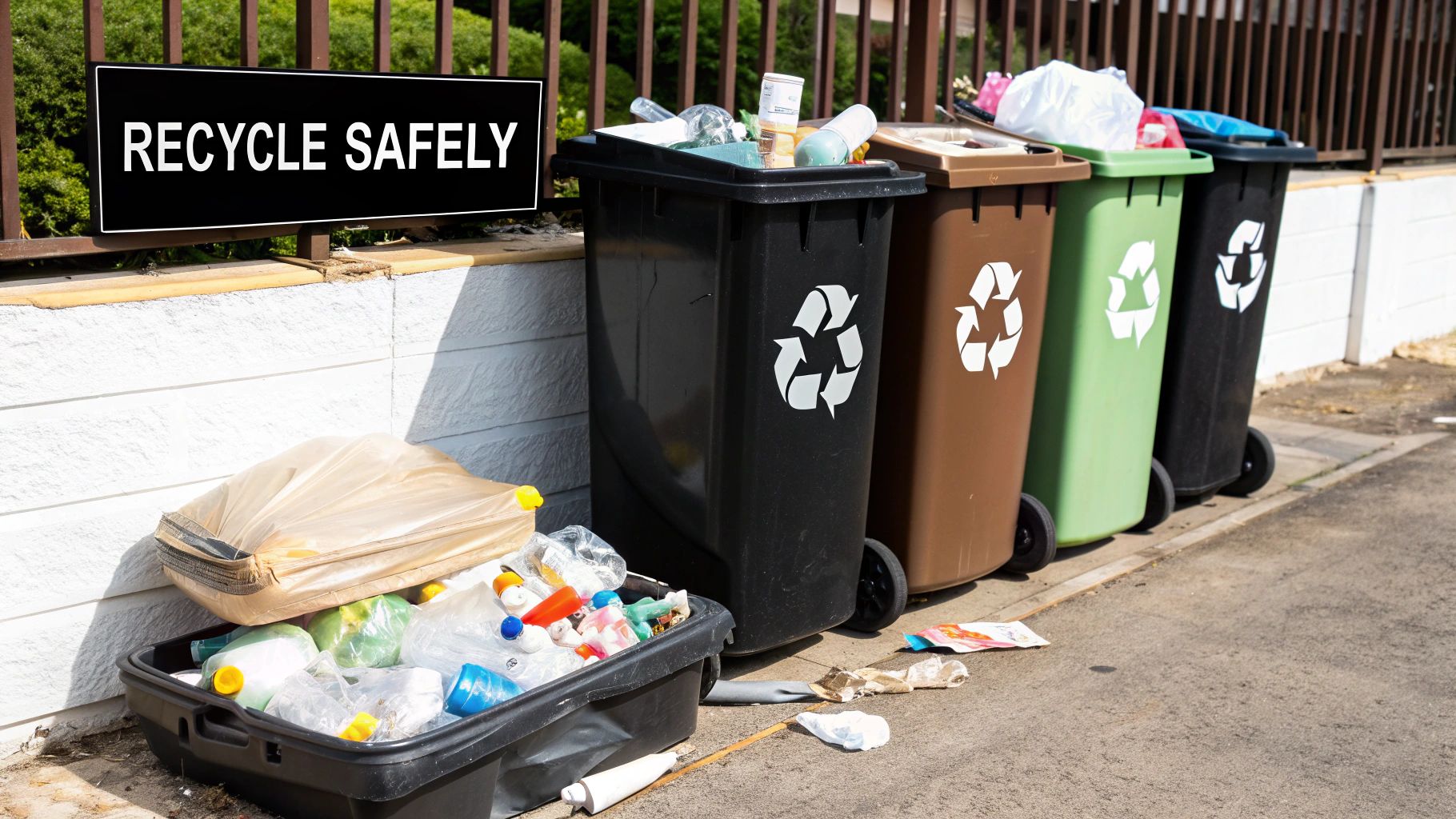
Harmful Chemicals in Plastics: Protect Your Health Today
Share
That plastic container holding last night's leftovers seems innocent enough, but it's part of a much bigger, more complicated story. Most plastics aren't just simple, inert materials. They're actually complex mixtures, often loaded with chemical additives that can leach into our food and, ultimately, our bodies. Let's pull back the curtain on these hidden ingredients and figure out how to avoid them.
Why Your Plastic Containers Aren't as Safe as You Think

We've all bought into the convenience of plastic, from our water bottles to food storage containers. It’s lightweight, it’s tough, and it just seems to fit perfectly into our busy lives. But this convenience comes with a hidden price tag, one linked directly to the chemicals added during manufacturing.
Think of the basic plastic itself as a simple chain. To make it useful—flexible enough to squeeze, colorful enough to sell, or strong enough to withstand heat—manufacturers blend in a cocktail of chemical additives. The real problem? These additives aren't permanently locked in.
Over time, especially when exposed to heat, regular wear and tear, or even just contact with acidic or fatty foods, these chemicals can migrate out of the plastic. They end up directly in our meals. It's an invisible transfer happening right in our own kitchens.
The Scale of the Plastic Problem
The sheer amount of plastic we've created makes this a global issue. Since the 1950s, we’ve churned out more than 8 billion tons of the stuff. Our ability to manage it all hasn't come close to keeping up. More than half of all plastic has ended up in landfills, and only about 9% has ever been recycled globally.
This staggering volume means there are countless opportunities for harmful plastic chemicals to seep into our environment and our bodies as all that waste slowly breaks down. You can get a clearer picture of the global plastic challenge and its impact by exploring the data on worldpopulationreview.com.
Beyond the "BPA-Free" Label
Many of us have learned to look for that reassuring "BPA-free" label, thinking it's a mark of safety. Unfortunately, it's often not the whole story.
In many cases, manufacturers simply replace Bisphenol A (BPA) with closely related chemicals, like Bisphenol S (BPS), which emerging research suggests might carry its own health risks. This is a classic case of "whack-a-mole," where one problem chemical is swapped for another. It’s a sobering reminder that we can’t always rely on marketing labels to protect us.
Real peace of mind comes from understanding the risks at their source and making deliberate choices. That's what this guide is all about—giving you the practical knowledge to create a healthier home. We'll be focusing on:
- Identifying Key Culprits: We’ll unmask the most common toxic additives, like phthalates and bisphenols.
- Understanding Health Impacts: We’ll connect the dots between chemical exposure and real-world health concerns.
- Taking Action: Most importantly, we'll give you simple, effective swaps for building a plastic-free pantry.
Meet the Chemical Culprits Lurking in Your Plastics
Ever wonder what makes one plastic rock-hard and another soft and bendy? The secret lies in a cocktail of chemical additives mixed into the base plastic. Think of it like baking: the base polymer is the flour, but the additives are the sugar, salt, and oils that create the final texture and properties. The problem is, many of these "secret ingredients" are toxic and don't always stay put.
They can leach out of the container and into your food, and from there, into your body. Let's pull back the curtain on the most common offenders you’ll find in a typical pantry.
This visual gives a quick, sobering look at the health risks these chemicals pose, especially to the developing bodies of children.

As the image highlights, kids are uniquely vulnerable to chemical exposure from everyday items. This is why knowing what to look for—and what to avoid—is so incredibly important for your family’s health.
To help you get a handle on what's what, here's a quick-reference table that breaks down the main chemical groups, where they hide, and in what common products.
A Guide to Common Harmful Chemicals in Plastics
| Chemical Group | Common Examples | Found In (Recycling Code) | Typical Products |
|---|---|---|---|
| Bisphenols | BPA, BPS, BPF | #7 (Polycarbonate) | Hard plastic water bottles, can linings, food storage containers, thermal paper receipts |
| Phthalates | DEHP, DBP, BBP | #3 (PVC/Vinyl) | Plastic food wrap, vinyl flooring, shower curtains, kids' toys, "fragrance" in cosmetics |
| Styrenes | Styrene | #6 (Polystyrene) | Disposable foam cups & plates (Styrofoam), takeout containers, packing peanuts |
| Vinyls | Vinyl Chloride | #3 (PVC/Vinyl) | Food packaging films, pipes, siding, some toys, teething rings |
This table is a starting point. By recognizing the recycling codes and product types, you can begin to spot potential hazards on store shelves. Now, let's dive a little deeper into why these chemicals are such a big deal.
The Hard Truth About Hard Plastics: Bisphenols
You’ve probably seen the "BPA-free" label everywhere. The chemical it refers to is Bisphenol A (BPA), a key ingredient in polycarbonate plastics. It's what gives those clear, rigid water bottles their shatterproof quality and lines most food cans to prevent corrosion.
So, what's the issue? BPA is a well-known endocrine disruptor. In simple terms, its chemical structure is so similar to the hormone estrogen that it can fool your body, throwing your entire hormonal system out of whack. This kind of interference has been linked to a troubling list of health problems, from reproductive issues to developmental delays in children.
But here’s the catch with those "BPA-free" labels. In many cases, manufacturers simply swapped BPA for a chemical cousin, like Bisphenol S (BPS) or Bisphenol F (BPF). Unfortunately, a growing body of research shows these substitutes can have similar, if not identical, hormone-disrupting effects. It often ends up being a classic case of "out of the frying pan and into the fire."
The Flexibility Façade: Phthalates
If bisphenols make plastics hard, phthalates (pronounced THAL-ates) do the exact opposite. They’re plasticizers, meaning they’re added to make plastics like PVC soft, flexible, and durable. They’re the reason your shower curtain doesn’t crack and your food wrap clings so well.
Like BPA, phthalates are also endocrine disruptors. They are particularly notorious for their anti-androgenic properties, which means they can interfere with male hormones like testosterone. This has raised serious red flags about their potential impact on male reproductive health.
A key problem with phthalates is that they aren't chemically bonded to the plastic. They are more like oil mixed with water—they can easily separate and leach out. They escape into the air, get absorbed through our skin, and migrate directly into fatty foods like cheese and meat when they're wrapped in plastic.
You'll find phthalates hiding in some obvious and not-so-obvious places:
- Plastic #3 (PVC/Vinyl): This is their primary home. Think vinyl flooring, inflatable toys, and those clear, flexible food containers.
- Food Packaging: That clingy plastic wrap is a major source.
- Personal Care Products: Oddly enough, they're used to make scents last longer. If you see "fragrance" or "parfum" on a label for lotion, shampoo, or soap, it could contain hidden phthalates.
Other Chemicals to Watch Out For
Beyond the big two, a few other materials deserve a spot on your "avoid" list.
First is Polyvinyl Chloride (PVC), also known as vinyl or recycling #3. It’s sometimes called the "poison plastic" for a reason. Its entire lifecycle is toxic—from its manufacturing, which releases carcinogenic dioxins, to the final product, which almost always contains dangerous additives like phthalates or heavy metals (lead, cadmium) to keep it stable.
Then there's Styrene, the building block for polystyrene (recycling #6). We know it best in its expanded form: Styrofoam. It's used for everything from disposable coffee cups and takeout clamshells to packing peanuts. The International Agency for Research on Cancer classifies styrene as a "probable human carcinogen." When you pour hot coffee into a foam cup, you risk styrene molecules leaching right into your drink.
Getting to know this lineup of chemical culprits is your first, most powerful step. When you can identify where these plastics show up, you can start making smarter, safer choices for your home and pantry.
How These Chemicals Affect Your Health

Knowing the names of these chemicals is one thing, but understanding what they do inside our bodies is what really hits home. These substances don't just pass through harmlessly. They can meddle with our most fundamental biological processes, leading to a whole host of health issues that often build up slowly over time.
Many of these plastic-derived chemicals are known as endocrine disruptors. Think of your endocrine system as your body's internal communication network. It’s made up of glands that produce hormones—the chemical messengers that control everything from your metabolism and mood to growth and reproduction.
Endocrine disruptors are masters of disguise. Their chemical structure is so similar to our natural hormones that they can actually fool our bodies.
Imagine your body’s hormone receptors are like locks, and your natural hormones are the perfectly cut keys. Endocrine disruptors are like counterfeit keys. They can jam the lock, blocking the real key, or they can turn it at the wrong time, sending faulty signals throughout your system.
This interference throws a wrench into a delicately balanced biological machine. The consequences can be especially serious during critical windows of development, like in the womb or during early childhood.
The Specific Health Risks of Common Chemicals
While the science is always evolving, decades of research have connected specific plastic additives to some very real health problems. When you connect the chemical to the consequence, it becomes crystal clear why cutting down on exposure is so important.
Here's a look at the two most infamous groups:
-
Bisphenols (BPA, BPS): Known primarily for mimicking the hormone estrogen, BPA exposure is linked to a long list of developmental and reproductive issues. Studies have tied it to early puberty, fertility struggles in both men and women, and a higher risk for certain hormone-driven cancers. It’s also been connected to metabolic disorders like obesity and type 2 diabetes.
-
Phthalates: These chemicals are a major concern for reproductive health because they can interfere with testosterone production. In scientific studies, exposure has been linked to developmental problems in the male reproductive system and lower sperm quality. Phthalates are also associated with a greater risk of allergies and asthma in kids.
These aren't just abstract theories; they are tangible health outcomes observed in study after study. The gradual, low-dose exposure from everyday plastic items adds up, creating a cumulative chemical burden on our bodies.
A Problem That Reaches Far Beyond Our Bodies
The health impact of these chemicals isn't just about what happens inside us—it’s deeply intertwined with the larger environmental crisis of plastic pollution. The mind-boggling amount of plastic we produce and throw away creates a constant, leaching source of contamination.
Our oceans bear the brunt of this. It's estimated that between 75 and 199 million tons of plastic waste are currently floating in marine environments. Single-use plastics make up about half of that, and as they break down over hundreds of years, they persistently release these toxic chemicals, harming wildlife and making their way into our food chain. You can learn more about the staggering scale of this issue from the ocean plastic statistics on condorferries.co.uk.
This cycle of contamination means our exposure isn't just from touching plastic. It also comes from the water we drink and the food we eat, especially seafood. It’s a vicious circle where our consumption habits create pollution that comes right back to impact our health.
Protecting the Most Vulnerable
While these chemicals pose a risk to everyone, some of us are far more susceptible to their effects. The developing bodies of fetuses, infants, and children are uniquely vulnerable to endocrine disruption.
During these crucial periods of growth, the body's hormonal signals are like a finely tuned orchestra, building organs, developing the brain, and laying the foundation for a healthy life. Even a tiny disruption during this time can have permanent consequences.
This is exactly why making conscious choices to lower your family's exposure is one of the most powerful things you can do. It's not about being perfect overnight. It's about building awareness and making small, meaningful changes to create a safer environment for the people you love.
Making Sense of 'BPA-Free' and Other Labels
You've probably seen it a thousand times while shopping: a product proudly sporting a ‘BPA-Free’ label. It's meant to be reassuring, a clear signal that you're making a safe choice for your family. But what does that label really mean? The truth is, it’s not as straightforward as it seems.
The story starts when the health risks of Bisphenol A (BPA) became common knowledge. People got worried, and rightly so. In response to the pressure, manufacturers started removing BPA from things like baby bottles, water bottles, and food containers. The problem wasn't what they took out, but what they put in instead.
The Truth Behind 'BPA-Free'
Many companies didn't fundamentally change their products to be safer. They just did a little chemical switcheroo. They swapped out BPA for its close chemical cousins, like Bisphenol S (BPS) or Bisphenol F (BPF). These compounds look and act a lot like BPA on a molecular level, and mounting research shows they can disrupt our hormones in very similar—and sometimes identical—ways.
This move is a classic example of what experts call "regrettable substitution." A well-known bad guy gets kicked out, only to be replaced by a lesser-known chemical that hasn't been put through the same scientific or regulatory scrutiny. As a shopper, you're left holding a product that feels safe but might carry the exact same risks.
A 'BPA-Free' sticker isn't a guaranteed seal of safety. It just tells you one specific chemical isn't there. It says nothing about the dozens of other potentially harmful bisphenols or plastic additives that might be.
That’s why you can’t always trust the marketing claims on the front of the package. To truly protect yourself, you have to look past the labels and consider the material itself. This is where materials like glass, stainless steel, and food-grade silicone really shine—they simply don't need these kinds of chemical additives to work.
Why Regulations Lag Behind Science
So, why aren't governments stepping in to put a stop to this? It’s a frustrating question. The simple answer is that our regulatory systems are slow, often playing catch-up to science and industry. In most places, a chemical is treated as innocent until proven guilty. That means a mountain of evidence has to pile up before regulators will take action.
This creates a dangerous gap. New, untested chemicals can be used in consumer products for years before enough research emerges to sound the alarm. It puts the burden on us, the consumers, to be vigilant.
Global economics don't help, either. Over the last 30 years, international tariffs on plastic goods have been slashed from an average of 34% down to just 7.2%. This makes products made from fossil fuels artificially cheap. Meanwhile, more sustainable alternatives like paper or bamboo are still hit with tariffs around 14.4%. It's a system that financially encourages the use of cheap plastics over safer materials. You can learn more about how trade policies fuel plastic pollution from the experts at UNCTAD.
At the end of the day, your best defense is to be a critical shopper. Don't just trust the label; question the material. Choosing products made from materials that are inherently free from these chemicals is the surest way to a safer, healthier home.
Your Action Plan for a Safer Kitchen
Alright, now that you know why you should be concerned about plastics, let's get to the good part: what you can actually do about it. This is where the rubber meets the road. Think of this as your practical playbook for kicking those harmful plastic-derived chemicals out of your kitchen, the heart of your home.
This isn't about a frantic, expensive overhaul that leaves you broke and stressed. It's about making smart, simple swaps over time. Small, consistent changes add up to a massive impact, creating a safer environment for you and your family in a way that feels totally manageable.
Smarter Food Storage Solutions
Let's be honest, one of the biggest culprits in our kitchens is how we store food. Leftovers, especially if they're fatty, acidic, or still warm, are a magnet for chemical leaching when they're sitting in plastic containers. Plastic wraps and zip-top bags aren't much better. A few key trades here can drastically cut down your daily exposure.
Here’s the thing to remember: plastic isn't a neutral, stable material. When it touches your food, a tiny, invisible transfer of chemicals can happen. The easiest way to sidestep this problem entirely is to choose materials that don't have those additives in the first place.
Here are some easy swaps to get you started:
- Glass Containers: Instead of those stacks of plastic tubs, switch to glass containers with airtight lids. Glass is non-porous and completely inert—it won't leach a single thing into your food, no matter what you store in it.
- Stainless Steel: For packing lunches or storing dry goods like rice and beans, stainless steel is a fantastic, lightweight, and virtually unbreakable option. It's especially great for kids' lunchboxes.
- Beeswax Wraps: Ditch the flimsy plastic cling film. Reusable beeswax wraps are a game-changer for covering bowls, wrapping sandwiches, or keeping that half-eaten avocado fresh without the phthalates.
- Silicone Bags: If you really can't part with the convenience of zip-top bags, look for high-quality, food-grade silicone alternatives. They're incredibly durable, reusable, and free from both BPA and phthalates.
The best part? These changes don't just reduce your family's chemical burden. They also slash your single-use waste, making your kitchen healthier for the planet, too. It’s a genuine win-win.
Safer Cooking and Heating Habits
Heat is plastic’s worst enemy. When you heat plastic, you’re essentially speeding up the breakdown of its chemical bonds, causing additives like BPA and phthalates to pour out at a much faster rate. A few simple rules around cooking and reheating can shield you from this amplified risk.
The single most important rule for a safer kitchen is this: plastic and heat should never mix. This includes the microwave, the dishwasher, and even leaving a water bottle to bake in a hot car.
Even those containers labeled "microwave-safe" are misleading. That label only guarantees the container won't melt into a puddle. It says nothing about the chemicals migrating into your meal.
To keep your food safe and delicious, just follow these golden rules:
- Never Microwave in Plastic: This is non-negotiable. Always, always transfer food to a glass or ceramic dish before you hit "start." It’s the single most effective change you can make.
- Hand-Wash Plastics: The combination of high heat and harsh detergents in a dishwasher chews away at plastic, creating micro-cracks that release more chemicals over time. If you absolutely must use plastic, wash it by hand in warm, soapy water.
- Use Non-Plastic Utensils: Stop using plastic spatulas or spoons to stir hot sauces or flip pancakes. Opt for wood, bamboo, or stainless steel to avoid melting plastic right into your dinner.
- Ditch the Non-Stick Pans: That slick non-stick coating is often made from a type of plastic polymer (PTFE) that can release toxic fumes at high temperatures. Cast iron, stainless steel, and high-quality ceramic cookware are far safer and can last a lifetime.
Simple Swaps to Reduce Chemical Exposure from Plastics
To help you visualize the transition, here’s a quick-reference table. Seeing the direct swaps laid out like this can make the whole process feel less daunting and a lot more straightforward.
| Instead of This Plastic Item | Try This Safer Alternative | Primary Benefit |
|---|---|---|
| Plastic Food Containers | Glass Jars or Stainless Steel Tins | Zero Leaching: These materials are inert and won't transfer chemicals into your food. |
| Plastic Cling Wrap | Beeswax Wraps or Silicone Lids | Reusable & Non-Toxic: Reduces waste and eliminates exposure to phthalates. |
| Plastic Water Bottles | Stainless Steel or Glass Bottle | Durability & Safety: Avoids BPA and microplastic ingestion from degraded plastic. |
| Plastic Cutting Boards | Wood or Bamboo Cutting Boards | Fewer Microplastics: Prevents tiny plastic particles from getting into your food. |
| Non-Stick Cookware | Cast Iron or Stainless Steel Pans | No Harmful Fumes: Eliminates the risk of releasing toxic chemicals at high heat. |
Making these adjustments is a powerful way to take back control of your health. Each swap, no matter how small it seems, is a deliberate choice to build a safer haven for you and your family, one item at a time. Your kitchen can be a true sanctuary of health, not a source of hidden exposure.
It's Time to Take Your Plastic-Free Vision Beyond the Kitchen
Once you start clearing plastics out of your pantry, a funny thing happens. You begin to see them everywhere. The awareness you’ve carefully built in the kitchen doesn’t just stop at the kitchen door; it starts to spill over into the rest of your home.
This last step is all about taking that new perspective and applying it to your whole life. It’s about spotting those same harmful chemicals in plastics that hide in plain sight, far from the food on your plate. Think of it less as a checklist and more as a new lens for seeing the world—one that empowers you to make smarter, healthier choices for you and your family.
Where Else Are Plastics Hiding?
The same logic you applied in the kitchen works just as well in the bathroom, the kids' playroom, and even your closet. You're already a pro at this: avoid heat, look for safer materials, and don't take labels at face value.
Here are a few key areas to start looking:
- Children’s Toys: We all know that just about everything a baby or toddler owns will end up in their mouth. That makes the material of their toys incredibly important. Try to choose toys made from natural wood, 100% silicone, or organic cotton. Steer clear of those soft, squishy PVC plastic toys, which are often loaded with phthalates.
- Personal Care Products: Your skin is your body's largest organ, and it can absorb chemicals from the things you put on it every day. Look for shampoos, lotions, and makeup packaged in glass or metal. Be a detective with the ingredients list—vague terms like “fragrance” can be a Trojan horse for phthalates. And always say no to products with plastic microbeads.
- Your Wardrobe: It's easy to forget that fabrics like polyester, nylon, and acrylic are just different forms of plastic. With every wash, they shed tiny microfibers that pollute our waterways and find their way back to us. Whenever you can, opt for natural fibers like organic cotton, linen, hemp, or wool.
Don’t underestimate the power of these small changes. Every conscious choice is a ripple effect—it lowers your family’s chemical exposure and tells manufacturers that we're demanding safer, better products.
The goal of this guide was to put you back in the driver's seat. By understanding the chemicals to watch out for, how they affect our health, and the simple swaps you can make, you're no longer a passive consumer.
Every plastic container you leave on the shelf in favor of a glass one is a win. Every time you reach for a beeswax wrap instead of cling film, you’re casting a vote for a healthier future for yourself and for the planet.
Still Have Questions About Plastics?
Digging into the world of plastics can feel overwhelming. It's easy to get lost in the jargon and conflicting information. Let's clear up some of the most common questions people have about plastic safety and what you can do about it.
Is "BPA-Free" Plastic Actually Safe?
It’s a label we’ve all learned to look for. Seeing "BPA-free" on a water bottle or food container feels like a win, but the reality is a bit more complicated.
When public pressure mounted against Bisphenol-A (BPA), manufacturers didn't reinvent the wheel. They often just swapped it out for similar chemicals like Bisphenol-S (BPS) or Bisphenol-F (BPF). This is a classic case of what experts call "regrettable substitution."
The trouble is, these replacement bisphenols are structurally very similar to BPA, and early research shows they can act in much the same way in our bodies, disrupting hormones and posing similar health risks. We essentially traded one problem chemical for another that just isn't as well-known yet.
Think of it this way: a "BPA-free" label doesn't mean a product is free from all bisphenols or other additives. The safest bet is always to choose materials that were never part of the problem to begin with, like glass, stainless steel, and food-grade silicone.
Can I Detox Plastic Chemicals From My Body?
This is a question that gets right to the heart of the matter. The good news is that our bodies are equipped with incredible detoxification systems, with the liver and kidneys doing the heavy lifting. Supporting these organs with plenty of water, a diet full of whole foods, and regular exercise is always a good idea.
But here’s the thing: you can't out-detox a constant stream of incoming chemicals. The single most powerful thing you can do is prevention. Reducing your exposure is far more effective than trying to cleanse your system later. When you stop putting these chemicals in, you give your body the fighting chance it needs to process and clear out what's already there.
What About Bioplastics? Are They a Good Alternative?
Bioplastics sound like the perfect solution, right? They’re made from renewable sources like cornstarch instead of petroleum, which is a definite plus for the planet.
From a health perspective, however, the story isn't so simple. A plastic's source material doesn't change the fact that it often needs chemical additives—like plasticizers for flexibility or stabilizers for durability—to function. These can be the very same types of chemicals we're trying to avoid in traditional plastics.
So, while bioplastics might be a step forward environmentally, they aren't automatically a healthier choice for food storage. For true peace of mind, inert materials like glass and stainless steel are still the gold standard.
Ready to build a pantry that’s truly safe and chemical-free? Naked Pantry brings organic, high-quality staples to your doorstep in 100% plastic-free packaging. Start creating your healthier kitchen today.
